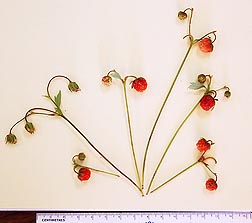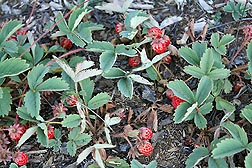New Strawberry Species Found in Oregon
|
|
A recently discovered wild strawberry species provides new genetic material for plant research and, in the future, might also provide a new class of commercial strawberries.
Agricultural Research Service scientist Kim Hummer, with the USDA-ARS National Clonal Germplasm Repository at Corvallis, Oregon, found the new species during several plant collection expeditions in the high peaks of Oregon’s Cascade Mountains. She named it Fragaria cascadensis.
The find was reported in the Journal of the Botanical Research Institute of Texas.
The new strawberry is endemic to the Oregon Cascades, hence its specific name, F. cascadensis. It is perennial, with white flowers and green leaves, and it differs from other strawberry species of the region by having hairs on the upper side of its leaves; a different-shaped middle leaflet; comma-shaped, small brown fruits (called “achenes”) on the strawberry surface; and 10 sets of chromosomes, unlike the 8 sets of chromosomes of the commercial strawberry, according to Hummer.
“The new strawberry species begins growing after snowmelt in late May or early June and flowers in early July. Runner production begins after flowering, and fruit ripens during August for about 2 weeks,” says Hummer. “The fruits of plants at about 5,000 feet elevation ripen 1 to 2 weeks later than those at 3,280 feet.”
|
|
The strawberry’s distribution in the Oregon Cascades stretches from the Columbia River in the north to the vicinity of Crater Lake in the south, at elevations of about 3,000 feet up to tree line. It grows in sandy-clay loam soil of volcanic origin located in forest clearings and open alpine meadows. The northern distribution range of F. cascadensis has an average annual precipitation of 12-15 inches, but the southern range receives only about 6 inches of precipitation annually.
This new strawberry is now included in the living collections of the Corvallis repository, which is a genebank that preserves invaluable plant genetic resources of temperate fruit, nut, and agronomic crops. This genebank maintains collections representing global diversity of blackberries, blueberries, cranberries, currants, gooseberries, hazelnuts, hops, pears, raspberries, and strawberries.
“Fragaria cascadensis presents the possibility for developing and breeding a new class of cultivated strawberries. This wild Oregon strawberry, if crossed with the commercial strawberry, would likely result in hybrid offspring with lower fertility,” says Hummer. “However, crossing this new species with other strawberries having the same number of chromosomes, such as the cultivated F. vescana or the wild Russian species F. iturupensis, should produce fertile offspring, which may reveal new flavors or genetic disease resistance. In the future, consumers could benefit from the knowledge gained and genes provided by this new wild strawberry.”—By Sharon Durham, Agricultural Research Service Information Staff.
This research is part of Plant Genetic Resources, Genomics, and Genetic Improvement, an ARS national program (#301) described at www.nps.ars.usda.gov.
Kim Hummer is with the USDA-ARS National Clonal Germplasm Repository, 33447 Peoria Rd., Corvallis, OR 97333; (541) 738-4200.
"New Strawberry Species Found in Oregon" was published in the July 2013 issue of Agricultural Research magazine.








